October 19th Scots Book of Days
October 19 – 202 BC – Second Punic War: At the Battle of Zama, Roman legions under Scipio Africanus defeat Hannibal Barca, leader of the invading Carthaginian army. Within 2 centuries, the Romans would invade the British Isles up to Caledonia, but stop and build 2 walls in an attempt to keep the Northern tribes at bay, forming the early border of Scotland.
439 – The Vandals, led by King Gaiseric, take Carthage in North Africa. A weakened Rome, sacked by Vandals and Goths (a century apart), will withdraw legions from the British Isles, stimulating immigration to Caledonia, from British fleeing invading Angles and Saxons. The original use of Caledonia, by Tacitus, Ptolemy, Lucan and Pliny the Elder, referred to the area (or parts) also known as Pictavia or Pictland north of Hadrian’s Wall in today’s Scotland. According to Historia Brittonum the site of the seventh battle of the mythical Arthur was a forest in what is now Scotland, called Coit Celidon in early Welsh.
http://www.bbc.co.uk/scotland/history/early_scotland/roman_forces_are_evacuated_from_britain/
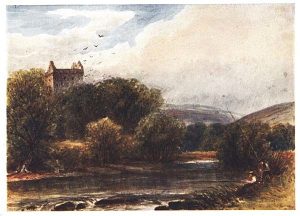 1216 – King John of England (descendant of Malcolm and Duncan Kings of Scots) dies at Newark-on-Trent and is succeeded by his nine-year-old son Henry.
1216 – King John of England (descendant of Malcolm and Duncan Kings of Scots) dies at Newark-on-Trent and is succeeded by his nine-year-old son Henry.
“HE PASS’D WHERE NEWARK’S STATELY TOWER LOOKS OUT FROM YARROW’S BIRCHEN BOWER” FROM A WATER-COLOUR SKETCH
PAINTED BY JAMES ORROCK, R.I. The Border country 1906.
1453 – The French (the auld alliance) recapture of Bordeaux brings the Hundred Years’ War to a close, with the English retaining only Calais on French soil.
1559 The Siege of Leith, Edinburgh’s port, and loss of Alexander Lockhart, brother of the Laird of Bar, is the turning point in British history.
Lockhart of Bar 1297 2Miller 2Simmons 2Choate 2Sorensen
Not only was it the end of the Auld Alliance with France and the completion of the Reformation in Scotland. It was the beginning of the United Kingdom.
http://www.leithhistory.co.uk/2006/11/26/the-seige-of-leith/
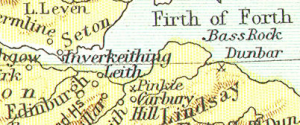 The Seige of Leith (Port for Edinburgh). The Lords of the Congregation (ie the Protestant Lords) [Argyll, Arran, Atholl, Balnaves, Boyd, Campbell, Douglas, Drummond, Erskine, Gordon, Kirkcaldy, Lindsay, Mar, Morton, Moray, Murray, Ochiltree, Ogilvy, Rothes, Ruthven, Stewart, Willock, Wishart, and Minister Knox] sent a demand to Leith in October 1559, for the Town of Leith to surrender within twelve hours or war would start in earnest. This demand was ignored. Blood soaked months followed.
Within Leith were 3000 French Soldiers, at the request of and supporting the French born Mary of Guise, Queen Regent, and Catholic widow of James 5th. Although the Scots army was larger, it was largely undisciplined and didn’t stand much of a chance against a disciplined French army fresh from the wars in Europe. [So wrote some ignorant author. Irrespective of any ‘lack discipline’ the Scots held the siege, awaiting reinforcements from England. When the English arrive, the French soldiers were allowed to evacuate and left forever. This victory at Leigth was the beginning of what would later be called the United Kingdom.]
The Seige of Leith (Port for Edinburgh). The Lords of the Congregation (ie the Protestant Lords) [Argyll, Arran, Atholl, Balnaves, Boyd, Campbell, Douglas, Drummond, Erskine, Gordon, Kirkcaldy, Lindsay, Mar, Morton, Moray, Murray, Ochiltree, Ogilvy, Rothes, Ruthven, Stewart, Willock, Wishart, and Minister Knox] sent a demand to Leith in October 1559, for the Town of Leith to surrender within twelve hours or war would start in earnest. This demand was ignored. Blood soaked months followed.
Within Leith were 3000 French Soldiers, at the request of and supporting the French born Mary of Guise, Queen Regent, and Catholic widow of James 5th. Although the Scots army was larger, it was largely undisciplined and didn’t stand much of a chance against a disciplined French army fresh from the wars in Europe. [So wrote some ignorant author. Irrespective of any ‘lack discipline’ the Scots held the siege, awaiting reinforcements from England. When the English arrive, the French soldiers were allowed to evacuate and left forever. This victory at Leigth was the beginning of what would later be called the United Kingdom.]
Location of Leith, the port for Edinburgh, on the Firth of Forth.
1579, King and Council informed infectioun and plague of the pistolence in towns and coast of England frequented by Scots shipping and Berwick, East and Middle Marches of England, markets at Dunds and Kelso forbidden and traders not to repair to infected places or break bulk of their wares. October 19. A History of Epidemics in Britain from A.D. 664 to the Extinction of Plague Charles Creighton, M.A. M.D. Demonstrator of Anatomy University of Cambridge. 1891
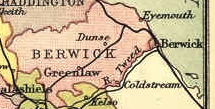 1688 William of Orange’s Dutch fleet sets sail. (TG54-319).
1688 William of Orange’s Dutch fleet sets sail. (TG54-319).
1715 MacIntosh forces reach village of Longformachus (TG68-317) for James 8th. the two armies of insurgents met at Rothbury, and inspected each other’s military state and equipments, [TG68-296].
Longformachus is 6 miles northwest of Duns in the Lammermuir Hills, in Berwick.
1696 sometime in. Failed harvest, severe famine, 5-15 percent starved to death. This was the seven ill years, a period of national famine in Scotland in the 1690s, by four years of failed harvests (1695, 1696 and 1698–99). The period is named after the Biblical famine in Egypt predicted by Joseph ben Jacob in the Book of Genesis. Famine may have been a push factor in the emigration to the American colonies and the West Indies (Alexander Hamilton’s was born there) by volunteers as indentured servants, which became the most significant form of transatlantic emigration from Scotland in this period.[22] Between 1650 and 1700 approximately 7,000 Scots migrated to America, 10–20,000 to Europe and England and 60–100,000 to Ireland.[23] Emigration to Ireland, particularly to Ulster, was a continuation of the Ulster Plantation, with cheap confiscated land in the north after James VII’s (1685-1688) invasions in the early 1690s. It has been estimated that 20,000 Scots emigrated to Ulster between the famine years 1696 and 1698. Wikipedia.
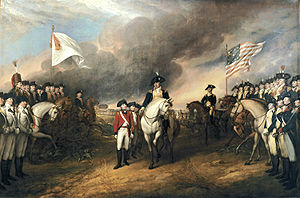 1781 –Yorktown, Virginia. American War of Independence. Surrender of Lord Cornwallis at the Siege of Yorktown, to General George Washington and vessels in harbour to French Admiral de Grasse.
1781 –Yorktown, Virginia. American War of Independence. Surrender of Lord Cornwallis at the Siege of Yorktown, to General George Washington and vessels in harbour to French Admiral de Grasse.
Surrender of Lord Cornwallis by John Trumbull, depicting the British surrendering to French (left) 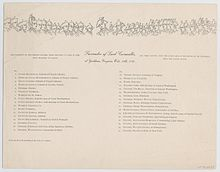 and American (right) troops. Oil on canvas, 1820, Yale University collection, and numerous other locations. Cornwallis’ daughter married a Cochrane.
and American (right) troops. Oil on canvas, 1820, Yale University collection, and numerous other locations. Cornwallis’ daughter married a Cochrane.
A key prepared by Trumbull identifying the French and American officers in the painting
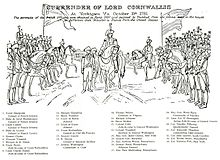 Another key to the painting. In the center of the scene, American General Benjamin Lincoln appears mounted on a white horse. He extends his right hand toward the sword carried by the surrendering British officer, who heads the long line of troops that extends into the background. To the left, French officers appear standing and mounted beneath the white banner of the royal Bourbon family. On the right are American officers beneath the Stars and Stripes; among them are the Marquis de Lafayette and Colonel Jonathan Trumbull, the brother of the painter. General George Washington, riding a brown horse, stayed in the background because Lord Cornwallis himself was not present for the surrender.
Another key to the painting. In the center of the scene, American General Benjamin Lincoln appears mounted on a white horse. He extends his right hand toward the sword carried by the surrendering British officer, who heads the long line of troops that extends into the background. To the left, French officers appear standing and mounted beneath the white banner of the royal Bourbon family. On the right are American officers beneath the Stars and Stripes; among them are the Marquis de Lafayette and Colonel Jonathan Trumbull, the brother of the painter. General George Washington, riding a brown horse, stayed in the background because Lord Cornwallis himself was not present for the surrender.
1790 – Lyman Hall, died, American signer of the Declaration of Independence (b. 1724). The Wallingford Connecticut high school is named for him, wherein Gretchen Choate taught French 1968-1969. (clan Hall).
Hall Crest: A Talbot’s head Motto: Vive Ut Vivas [“Live, So That You May Live”] ” – Seat: Liddesdale, Roxburghshire
1812 – Moscow, Russia. Napoleon I of France army retreats from city, leaving Marshal Mortier, with the rear guard to blow up the arsenals, the magazines, and Kremlin. The route west was thru 300 miles of devastated country with assaults by hordes of Cossacks.
1813 – The Battle of Leipzig concludes, giving Napoleon Bonaparte one of his worst defeats.
1856 Continental Divide Wyoming Territory. https://www.lds.org/general-conference/1991/10/our-mission-of-saving?lang=eng ‘’ On October 19, [the Purcell family] reached the last crossing of the Platte, a little west of the present city of Casper, Wyoming. The river was wide, the current strong, and chunks of ice were floating in the water. They were now traveling without sufficient food. Bravely they waded through the icy stream. A terrible storm arose with fierce winds bringing drifting sand, hail, and snow. When they climbed the far bank of the river, their wet clothing froze to their bodies. Exhausted, freezing, and without strength to go on, some quietly sat down, and while they sat, they died.
Ellen’s mother, Margaret, became sick. Her husband lifted her onto the cart. They were now climbing in elevation toward the Continental Divide, and it was uphill all the way. Can you see this family in your imagination?—the mother too sick and weak to walk, the father thin and emaciated, struggling to pull the cart, as the two little girls push from behind with swirling, cold winds about them, and around them are hundreds of others similarly struggling.
They came to a stream of freezing water. The father, while crossing, slipped on a rock and fell. Struggling to his feet, he reached the shore, wet and chilled. Sometime later he sat down to rest. He quietly died, his senses numbed by the cold. His wife died five days later. I do not know how or where their frozen bodies were buried in that desolate, white wilderness. I do know that the ground was frozen and that the snow was piled in drifts and that the two little girls were now orphans.’’
Ellen married William Unthank. And was known as Nellie Unthank. Unthank is a hemlet in Angus Scotland.
1914 – The First Battle of Ypres begins.
1933 – Nazi Germany withdraws from the League of Nations.
1935 – The League of Nations places economic sanctions on fascist Italy for its invasion of Ethiopia, pushing Italy toward alliance with Germany.
1940 Destroyer “VENETIA”, of World War 1 vintage was sunk by a mine in the Thames Estuary while on patrol. Birmingham, Liverpool and Manchester joined London as targets for German bombers in the Blitz. www.naval-history
Disclaimer: The author of each article published on this web site owns his or her own words. The opinions, beliefs and viewpoints expressed by the various authors and forum participants on this site do not necessarily reflect the opinions, beliefs and viewpoints of Utah Standard News or official policies of the USN and may actually reflect positions that USN actively opposes. No claim in public domain or fair use. © John Choate.
Utah Standard News depends on the support of readers like you.
Good Journalism requires time, expertise, passion and money. We know you appreciate the coverage here. Please help us to continue as an alternative news website by becoming a subscriber or making a donation. To learn more about our subscription options or make a donation, click here.
To Advertise on UtahStandardNews.com, please contact us at: ed@utahstandardnews.com.


Comments - No Responses to “October 19th Scots Book of Days”
Sure is empty down here...